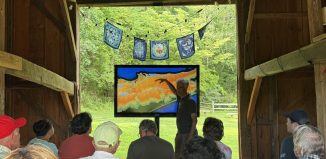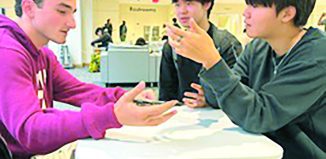North Shore school districts embrace English language learners

School districts across the North Shore have experienced an increase in English language learners over the last several years.
English language learner refers to a student who is age 5 or older and who is learning English as a New Language — formerly known as English as a Second Language. This is an approach in which students who are not native English speakers are mainly taught in English. The respective abbreviated current terms are ELL and ENL.
Students tackling English
The number of English language learners varies from district to district along the North Shore of Western Suffolk County. For example, In the Middle Country school district, a spokesperson said 639 were enrolled in the ENL program this year out of the 8,534 students attending. Smaller districts such as Cold Spring Harbor had 15 students learning English, with 1,585 students overall in 2020-21. Port Jefferson had 38 ELL students with an overall enrollment of 962, according to the New York State Education Department website, during the same school year.
While some districts have seen an increase in ELL students, some have seen a decrease or have remained steady. According to a district spokesperson for the Northport-East Northport school district, the number of ELL students has remained stable. Currently, out of the 4,533 students enrolled in the district, 167 are ELL students, which is approximately 3.7% of the student population.
A spokesperson for Harborfields and Elwood school districts said Harborfields has experienced a modest decrease from 3.8% of the student population being ELL students last year to 3.6% this year. In Elwood, the percentage has increased slightly from 6.1% at the end of June to approximately 6.3% at the beginning of this academic year.
According to administrators from local districts, while the majority of students enrolled as English language learners are Spanish speaking, other languages spoken are Chinese dialects, Portuguese, Korean, Turkish, Hebrew, Hungarian, Ukrainian and Urdu, the official language of Pakistan. A smaller percentage speak Russian, Haitian Creole, Arabic, languages from India such as Tamil and Telugu and the Iranian Pashto, according to NYSED.
Kerri Golini, Three Village school district’s director of World Language and English as a New Language, said the ENL population in the district has increased by 21% in the past year. Currently, these students represent 2% of the district’s overall population.
While 13 different languages are spoken in the Three Village program, the majority of students speak Spanish and Chinese dialects.
New York State guidelines require ELL students to have integrated and stand-alone classes depending on comprehension level. In addition to instruction, there are also opportunities for parents to partake in activities.
“All families go through an orientation when their students are screened,” Golini said. “In the fall we host a parent academy to help families navigate the website, use email to communicate, complete forms requested by the district, [submit] applications for free and reduced lunch, and access the parent portal.”
Golini said it’s the district’s “goal to increase parent engagement.”
“Student success increases when there is someone at home who is involved in the child’s education,” she said.
Vicenza Graham, director of World Languages, ENL and Library Media Services in the Smithtown school district, said, families in the district also receive an orientation with translation services “in order to help acclimate our newcomers to their new school environment.”
As for studies, Graham said, “Students receive modified work based on their proficiency levels and lesson plans include scaffolded materials with both content and language objectives.”
Nicole Waldbauer, director of humanities at Shoreham-Wading River school district, said during her five-year tenure as director, the number of students has grown steadily by a few each year. Last year, she said there were 27 students throughout the district, and this year 29. The students represent less than 1.5% of the student population.
When she started with the district, she said there was one ENL teacher, who would travel to the different school buildings as the students are spread out throughout the grades and schools. Now there are three instructors, plus additional hours for them to work. When the hours are combined, they are the equivalent of a part-time position for the district.
Depending on their levels, determined by an assessment, the students are either in a co-taught class or general education class where the ENL teacher will be available for support. Children who are less proficient in English will have a stand-alone period for one-on-one with a teacher.
“The way that the state regulations work, their level dictates how many minutes of one-to-one or small group instruction they get strictly in ENL versus how many minutes they get of integrated co-teaching,” Waldbauer said. “They’re not separated from the general population. That was a change over time that the state ed department had made to make sure that there was more inclusivity.”
Fun ways to learn
Educators have found various ways to help children learn the English language, acclimate to life on Long Island and sometimes include the parents in leisure activities.
Golini said in the Three Village distinct a social event is held for all ELL families in the spring “to provide them with an opportunity to connect with each other and feel a part of the community.”
With COVID-19 restrictions lifted, Golini said the hope is to plan more evening events for the families. She has also worked with teachers to help increase ELL students’ participation in extracurricular activities and sports.
“We had more ELLs involved in the 3V community this past year than ever before,” she said.
Other activities in the district included elementary students visiting the library and high school students touring the Suffolk County Community College campus.
Toward the end of the 2021-22 school year, Harborfields High School’s English language learners visited Stony Brook University where they toured the buildings, lecture halls, student center and library, according to a district press release. The trip allowed students to explore post-secondary education options. While on campus, the high school students also interviewed an SBU student.
In the same district, at the end of last school year, Oldfield Middle School students went on a field trip to the Cradle of Aviation Museum in Garden City to learn about aviation and aerospace history on Long Island.
In the Smithtown school district, in the fall of 2021, Accompsett Middle School students created welcome signs in their native languages. In addition to English, the signs were written in Hebrew, Hungarian, Korean, Mandarin, Spanish, Turkish and Ukrainian.
Waldbauer said with grant money, the Shoreham-Wading River district was able to have an after-school tutoring program for ENL students from K to 8. Last year there was also a Saturday enrichment program that included field trips for the students and their families who along with the teachers and Waldbauer, visited places such as Quogue Wildlife Refuge and the Long Island Aquarium.
“The goal of that was to get the families all together and to have them make connections, but then also giving them a safe space and place to integrate into the community with people there,” she said.
Teachers
While the increase of English language learners hasn’t been drastic, districts at times compete with neighboring communities to secure ENL teachers as the number of teachers certified in the field hasn’t kept up with the increase of students.
Waldbauer said ENL teachers are special and unique people who ensure students are receiving a proper education and any services they need, plus are in touch with parents regularly answering any questions they may have: “They go above and beyond with just instructing the kids.”






